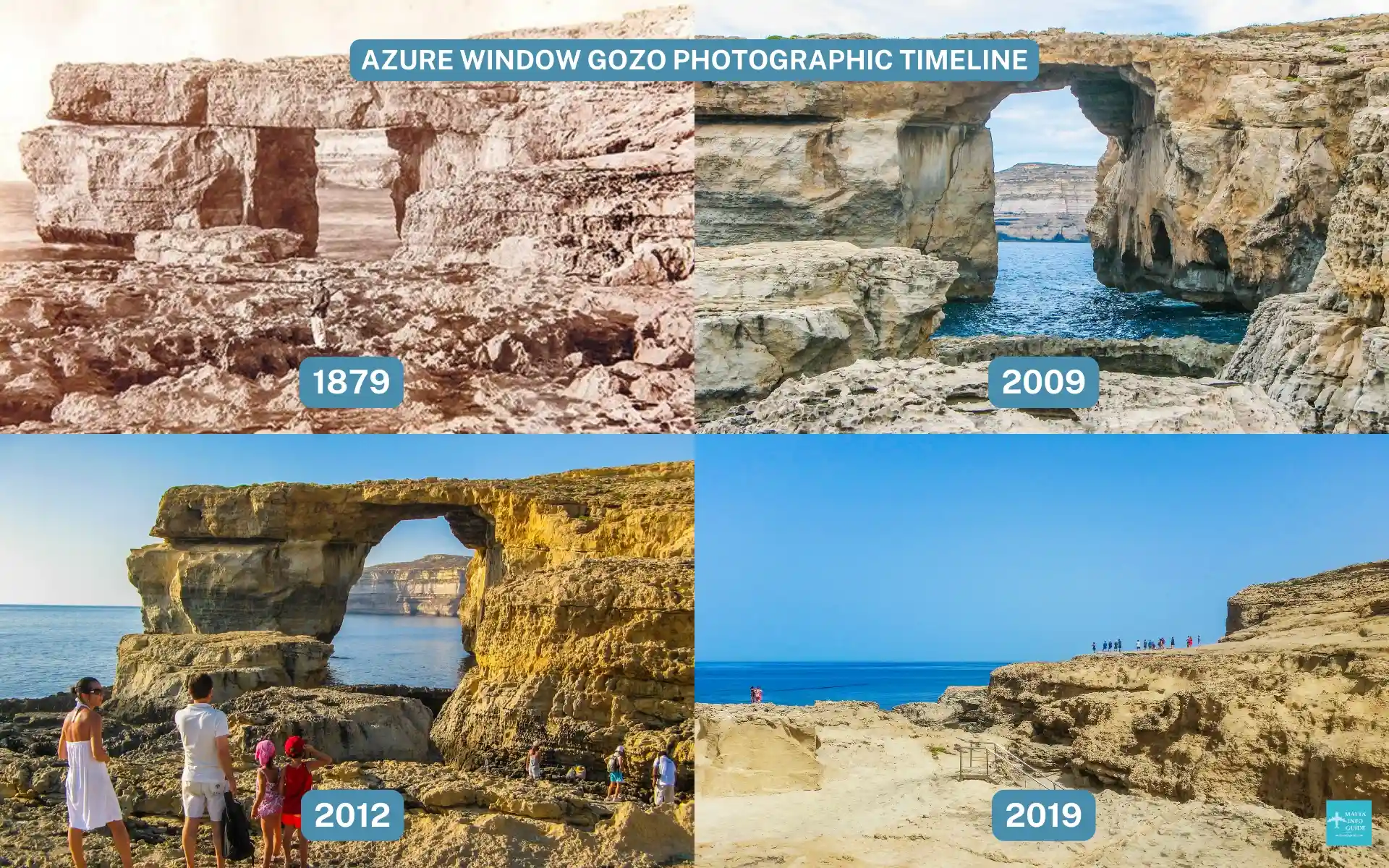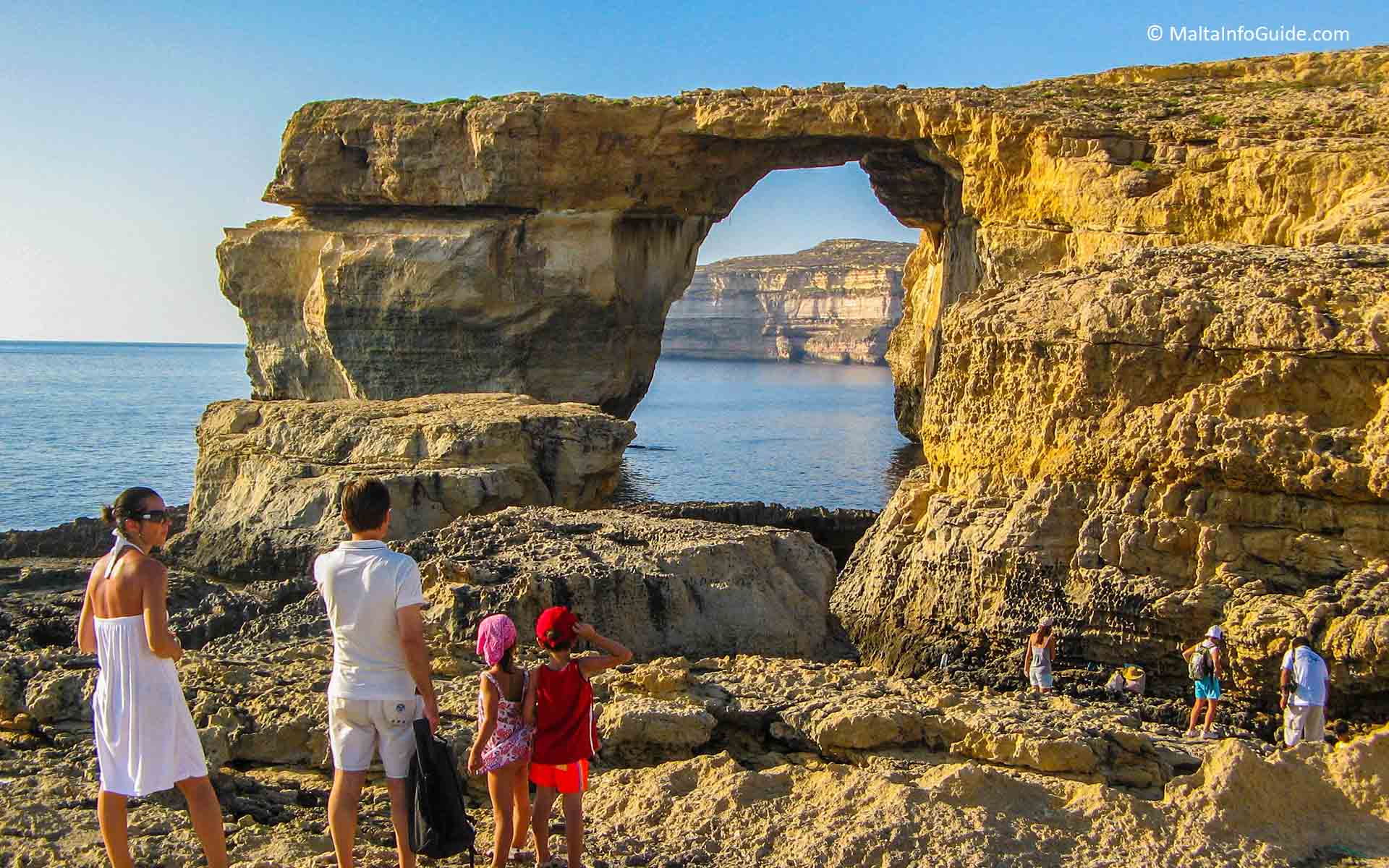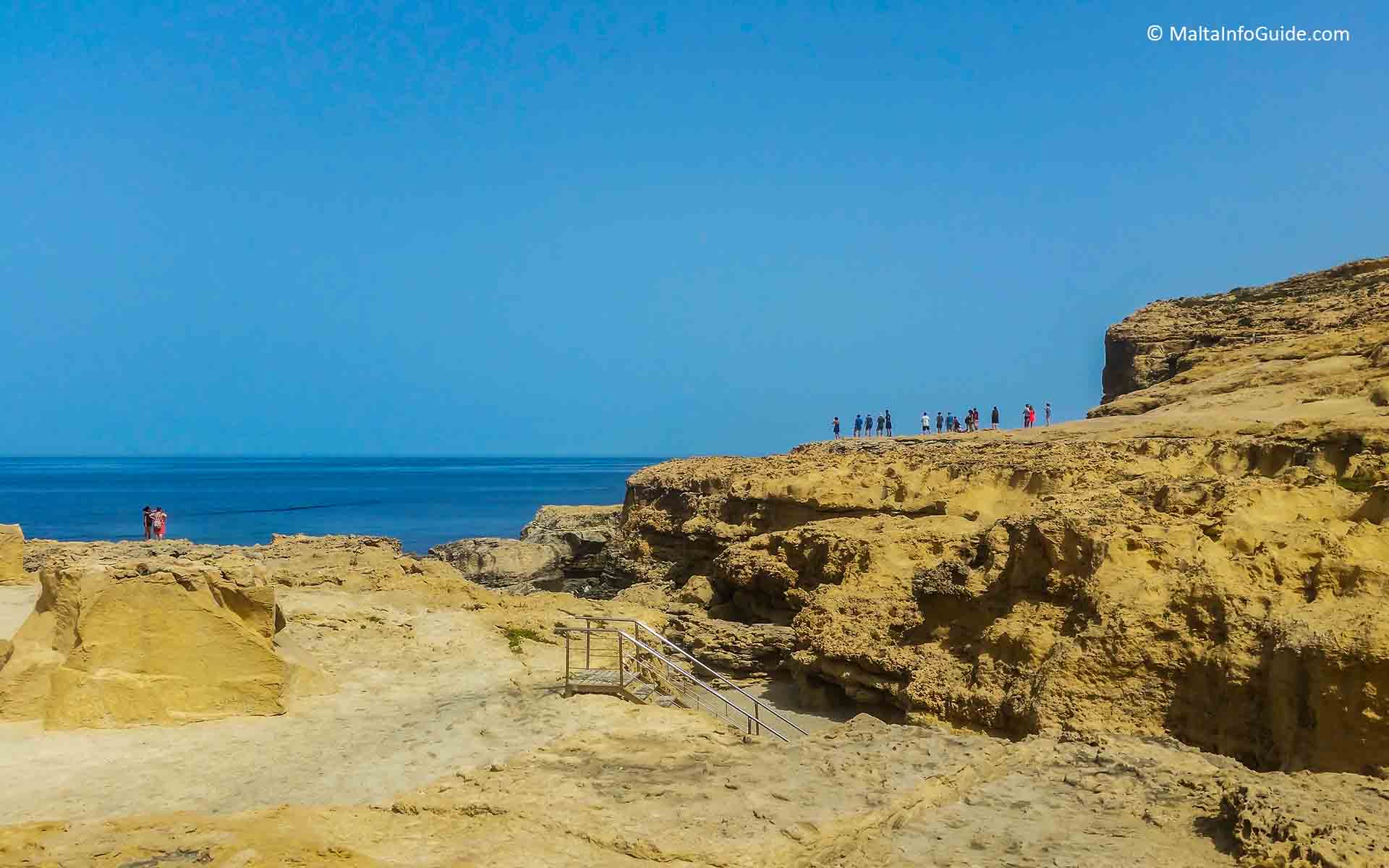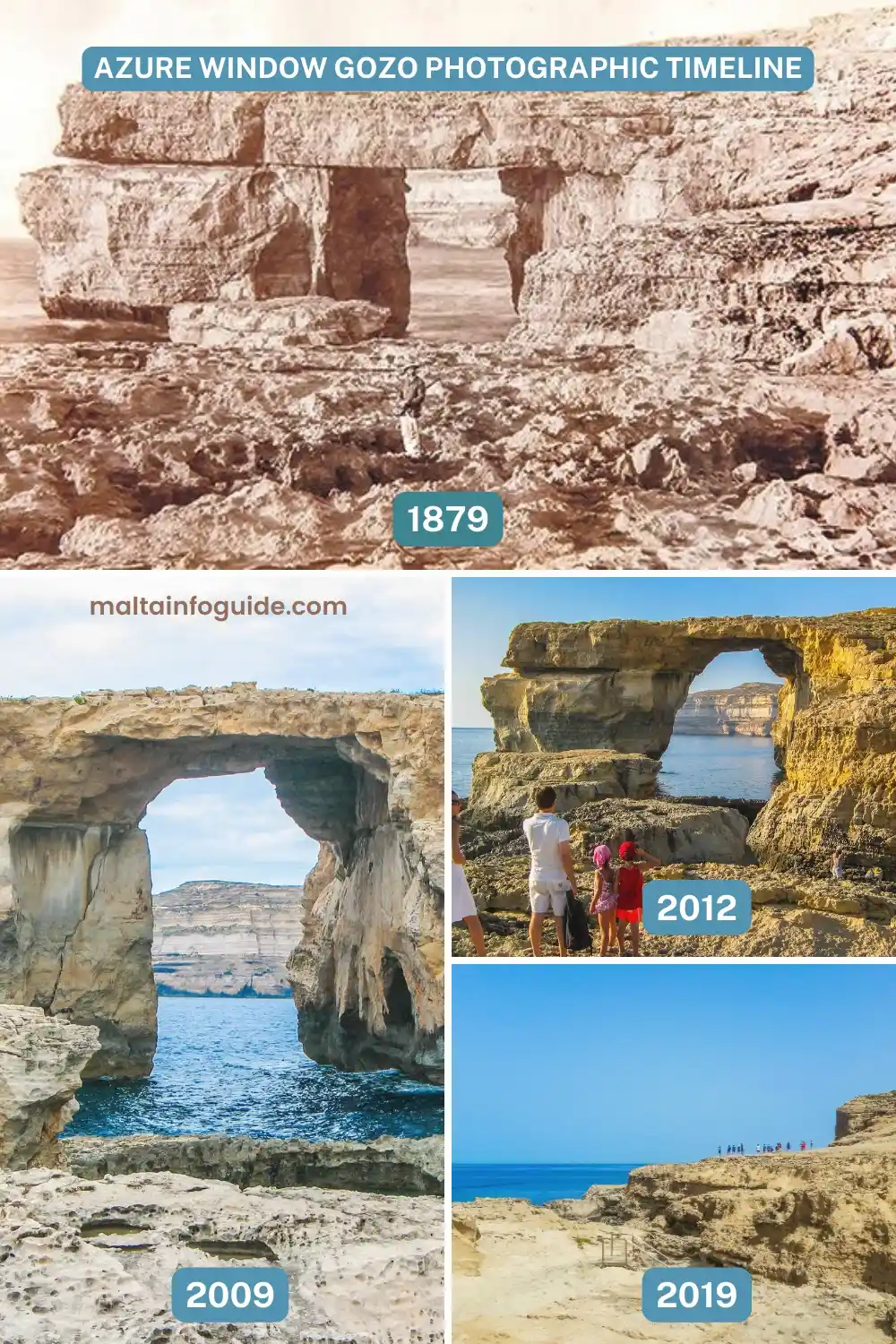- Home
- Gozo Island
- The Azure Window
the Azure Window Gozo
The Collapsed Natural Window An Natural Icon Of The Maltese Islands
The Azure Window was certainly one of the most eye-catching attractions of the island until its collapse at about 9:40 am local time (8:40 am UTC) on Wednesday, 8th March 2017. It was considered one of Gozo's best-known landmarks together with the Dwejra Inland Sea, the Fungus Rock, the Dwejra Tower and for divers, the Blue Hole.
 Timeline of Azure Window From 1879 to 2019
Timeline of Azure Window From 1879 to 2019what to find on the azure window article
- Facts About The Azure Window Gozo
- Historic & Geologic Azure Window Overview
- The Azure Window Collapse
- Films Featured At This Location
- Things To Do Around And In Gozo
- Frequently Asked Questions About Azure Window In Malta
Facts About The Azure Window Gozo
- The window collapsed on 8th March 2017.
- The height of the window was 28 meters (92 feet).
- The width of the window was 25 meters (82 feet).
- Multiple movies were filmed at the Dwejra Heritage Park with a backdrop of the window.
- Still considered a popular site to visit, although the window no longer exists.
- There were suggestions for the project to rebuild the Azure Window digitally, keep it as it is, and introduce Svetozar Andreev's "Heart of Malta" steel arch.
- The Dwejra area, including the Azure Window, was one of seven Maltese sites in the tentative list for the UNESCO World Heritage status in 1998. These sites have not yet been formally approved by UNESCO.
📹 Top 7 Best Places To Visit in Malta For 2025
Wondering which spots in Malta should be on your 2025 travel list? Join us on a journey across Malta as we highlight breathtaking views, cultural gems, and experiences you won’t want to miss. Subscribe to our YouTube channel for more content like this. (Sound ON 🔊)
Historic & Geologic Azure Window Overview
The Azure Window was a squarish, massive arch that was formed naturally as part of the Gozo rock formations. The sea flowed through this enormous aperture, exposing the craggy rocks behind it.
It was known for being the most photographed landmark in Gozo due to its enormous size and structure that captivated many of the spectators. Visitors would see hundreds of fossilised shells embedded in the rocks as they got closer, gradually realising the enormity of the structure. Every time we visited, the water presented a new experience due to its constantly shifting moods.
The Azure Window, formed over millennia by the unrelenting forces of wind and water, was bound to fall in due course. A large chunk of the outer megalith collapsed only sometime before, indicating that this natural wonder will perish.
 The Azure Window 5 years before collapsing
The Azure Window 5 years before collapsingHow was the Azure Window
formed
The Azure Window developed through natural erosion of the rock formation where the sea with its mighty force of waves erodes little by little the rocks at sea level. Also, the rain has its share where it seeps in and creates natural passages until it finds its way to the sea.
How the arch formed - It was eroded through many years, where at one time the middle area started to be eroded quicker than other parts. This could have happened through waves hitting harder at that position, and also by weaker and fissured rocks that crumble quicker.
Some think that it took thousands of years, and others a couple of hundred years.
A well-known local photographer Mr Daniel Cilia had suggested through research that he conducted that the window could be around 140 years old. He observed several paintings, photos and through a journal entry that the window formed between 1866 and 1879.
On the other hand, the Gozo San Lawrenz Mayor Mr Noel Formosa believes that it could date back a few hundred years.
The Azure Window Collapse
On 8th March 2017 at around 9:40 am local time (8:40 am UTC) the Azure Window collapsed during a strong gale force storm which hit the Maltese islands the day before. Nothing remained visible above sea level.
 The Collapsed Azure Window Photographed In 2019
The Collapsed Azure Window Photographed In 2019local resident experiencing the window falling
On that same day Roger Chessell, a Xagħra resident was at Dwejra to take photographs of the storm where he witnessed the collapse.
This is what he said: "There was a big raging sea beneath the window,” he told the Times of Malta. “Suddenly, the arch collapsed into the sea with a loud whoomph, throwing up a huge spray. By the time the spray had faded, the stack had gone too." [1]
For the Gozitans, it was a historic heritage. The big rocks are now lying at the bottom of the Mediterranean Sea.
how did the azure window fall?
The white huge rocks that got fragmented from the massive arch
found themselves at the bottom of the Mediterranean Sea forming massive uneven
structures that are an attraction to divers. They are impressive with various
natural cantons and passages for divers to explore.
The pillar gave way under the heavy battering of the waves where here they are known to be very rough. The window pillar and arch collapsed into massive chunks of rock which all piled on each other under the sea with nothing visible above sea level.
The white rocks will not remain as they are for long as the
marine life is already shaping itself on their surface and for this reason divers are eager to dive now not later.
The site can be explored with a few dives as it is spread over a wide area. It is ideal for a variety of diver certifications ranging from 5 meters to 52 meters deep. Divers have been told to use registered clubs to dive around the site.
The video below is a detailed explanation with animated footage of the Azure Window Falling by Professor Joseph Caruana and John Wood explaining how the window fell according to their three-year study they did together with other scientists. The video is in Maltese, however there are English subtitles to follow.

Azure window underwater
A year after its collapse, the iconic Gozitan landmark is now a diving attraction. Divers enjoy exploring the area which has caused a hit in the media news and tourists are visiting the areas where the window used to stand still enjoying taking photos of the site.
The underwater wonders that have formed from the remains of the Azure Window were documented and shown on YouTube. The video reveals massive huge boulders of limestone spread all across the seabed with many cracks and sharp edges. All very clear until the marine life takes over all the limestone surfaces. In fact, after a year, this is what happened.
It is important to say that the top part of the arch fell in one whole chunk.
The depth ranges from 8 metres to 57 metres. This is suitable for different dives of divers with different certifications. It requires a number of dives to explore all the spreading sites.

The Azure Window today
The Azure Window was a landmark that thousands of Maltese used to visit either when arriving in Gozo or before heading back to Malta. A visit to Gozo was never complete without seeing the window. When the news came out that the window had perished, it went viral and made headlines on international news such as the BBC. [2]
The former Maltese Prime Minister Joseph Muscat declared the event as “heartbreaking”. [1]
The news was so shocking for us locals that many people visited the site to see for themselves, as they couldn't believe it. It was the talk of the day for some time until everyone accepted the reality.
Films Featured At This Location
The Maltese islands have been involved with the film industry since 1925 where around 100 feature films have been shot in Malta either entirely or partially. The earliest film was called ‘Sons of the Sea’.
Various feature films and series that had included the Azure Window and its surroundings.
- Clash of the Titans was released in 1981.
- The Count of Monte Cristo was released in 2002.
- The Odyssey' in 1997, an American television miniseries.
- Game of Thrones is a drama television series broadcast between April 2011 and May 2019.
- Sing Handed during the early fifties.
- Actor III in 1985.
- Among Wolves during 1985.
- Christopher Columbus – The discovery was released in 1992.
- Documentary scenes for Nonsolomoda an Italian program shown on Rete 4 and Canale 5 of Mediaset.
- The First Eden: The Mediterranean World of Man which explored the history and culture of the Mediterranean Sea.
- The Mountain of Diamonds – Italian / French production.
*SPOILER ALERT! This following paragraph may contain spoilers!*
game of thrones azure window
The Azure Window was one of the filming locations of HBO's fantasy series, Game Of Thrones. This location was used in Season 1 to film the Dothraki wedding of Khal Drogo (Jason Momoa) and Daenerys (Emilia Clarke).
things to do around and in gozo
Beyond the Dwejra region and the Azure Window, Gozo has an abundance of experiences and activities to offer, all of which contribute to the island's peaceful and very lovely ambience.
- Tour the Cittadella and Victoria: Explore the Cittadella, an old fortification in Victoria, Gozo, which has museums, the Cathedral of the Assumption, and sweeping vistas. Discover the traditional food, quaint streets, and handcrafted goods in Victoria.
- Visit the Ġgantija Temples: The amazing Ggantija Temples can be visited as UNESCO World Heritage Sites as they are among the oldest free-standing buildings in the world.
- Take a Walk in the Countryside: Gozo is known for its stunning scenery and serene surroundings. Explore the natural beauty of the island by strolling along its rustic roads and verdant valleys, such as the Wied il-Ghasri valley.
- Explore the Beaches of Gozo: Every beach in Gozo offers a unique experience. There's nothing like the serenity of Dahlet Qorrot and Ramla Bay. There is a hive of activity at Marsalforn Bay and Xlendi Bay with their natural beaches and water activities. Swimmers can enjoy peaceful swims in the pristine waters of the more sedate Qbajjar and Mgarr ix-Xini.
- Experience Local Cuisine: Fresh fish, freshly prepared pasta, and traditional pastries like kannoli and qassatat are highlights of Gozo's culinary scene. Each dish is enhanced by locally produced wines and seasonal ingredients, providing a distinctive culinary experience.
- Discover Gozo’s Artisan Crafts: Visit the crafts village at Ta' Dbieġi and meet local artisans. Witness firsthand the making of lace, glass-blowing, and other traditional crafts that Gozo is famous for. This is a great opportunity to pick up unique souvenirs and gifts.
Wied il-Mielaħ Window
Translated as "The Salt Valley Window" is a striking natural limestone arch located close to the villages of Zebbug, Ghasri, and Gharb on Gozo's northwest coast.
This less well-known arch, which gained fame after the Azure Window collapsed, has breathtaking views from a cliff top and is perfect for thrill-seekers. Due to its tiny, uneven roads, the site is only accessible by quadbike or scooter. It is recommended to visit the site carefully, especially if you are travelling with little children.
Wied il-Mielaħ, which is free to explore, offers a peaceful and scenic haven that captures the untamed beauty of the Mediterranean without the hordes of visitors found in more well-known locations.
frequently asked questions about azure window in malta
What was the Azure Window?
What was the Azure Window?
The Azure Window was a natural limestone arch at Dwejra in Gozo, Malta. It was well-known for its gorgeous aspect and was a favourite destination for photographers and tourists.
When and why did the Azure Window collapse?
When and why did the Azure Window collapse?
The Azure Window fell on March 8, 2017, as a result of natural erosion aggravated by powerful storms. The arch has weakened over time owing to wind and wave activity.
Can I still visit the location where the Azure Window previously stood?
Can I still visit the location where the Azure Window previously stood?
Yes, you may still visit the spot in Dwejra Bay. The region remains a popular tourist attraction due to its stunning coastline vistas, diving opportunities, and geological importance. You can see the Inland Sea, Dwejra Tower and the Fungus Rock.
Is there any evidence of the Azure Window under the sea?
Is there any evidence of the Azure Window under the sea?
Yes, the ruins of the Azure Window are now on the seabed, forming a unique underwater environment that has become a popular diving destination.
Is it safe to swim near where the Azure Window was located?
Is it safe to swim near where the Azure Window was located?
Swimming in the area where the Azure Window was located is generally safe, however it is critical to follow local advice because currents can be strong. The Blue Hole, located nearby, is a popular and safer swimming and diving spot. Furthermore, the scenery of this location is incredibly beautiful and appealing, making it a peaceful and scenic destination for travellers seeking both action and tranquillity.
What additional sights are around the old location of the Azure Window?
What additional sights are around the old location of the Azure Window?
Dwejra Tower, the Inland Sea, Fungus Rock, and the Blue Hole are all within walking distance and provide unique natural and historical experiences.
Did the Azure Window appear in any films or television shows?
Did the Azure Window appear in any films or television shows?
Yes, the Azure Window emerged to prominence as the filming location for the Dothraki wedding scene in season one of "Game of Thrones."
Is there a plan to recreate or replace the Azure Window?
Is there a plan to recreate or replace the Azure Window?
There are currently no plans to artificially reproduce the Azure Window. The primary goal is to preserve the natural environment while also promoting the area's other natural qualities.
What is the best time of year to visit the site of the Azure Window?
What is the best time of year to visit the site of the Azure Window?
The site can be visited year-round, but the best weather conditions are typically from late spring to early autumn, offering warmer temperatures and calmer seas. Being one of the prime areas in Gozo you will see tourists all year round.
Want To Share This Page On Pinterest? Pin It Here!
azure window sources
- Times Of Malta - The Azure Window is lost and gone forever [1]
- BBC - Malta's Azure Window collapses into the sea [2]
- Setting up the first coastal nature reserve in Malta
🏨 Find the Best Places to Stay Nearby
This fantastic interactive map below helps you discover the best accommodation across the island from a variety of trusted platforms. Explore different areas, compare prices, and book directly all in one place.
🚗 Need a car for your Trip to Malta?
Discovering the beauty of this gem in the Mediterranean by car is certainly the best way to experience its hidden beaches, charming villages, and also hidden paths that are difficult to reach by public transport.
Find The Best Rates On Your Car Rental Now!
 By Albert and Benjamin Magro
By Albert and Benjamin Magro





